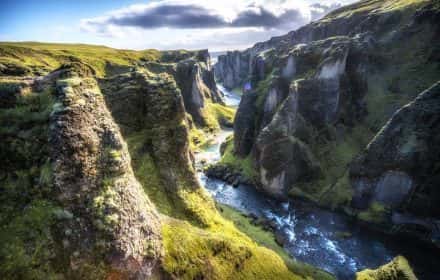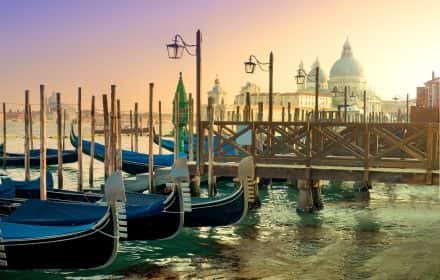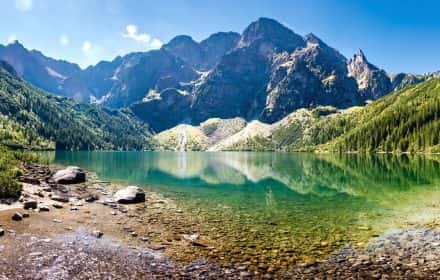This site uses affiliate links, meaning that if you make a purchase through our links, we may earn an affiliate commission.
Venice, the city of timeless romance and picturesque canals, owes much of its allure to the enigmatic figures known as Venetian gondoliers.
These skilled oarsmen have long been the custodians of Venice’s unique waterways, and their presence adds a touch of magic to every ripple in the canals.
In this captivating journey through the world of Venetian gondoliers, we will delve into the heart of their enigmatic profession, unveiling fascinating insights that shed light on the secrets, traditions, and captivating stories that make these masters of the canals an integral part of Venice’s cultural tapestry.
Join us as we navigate the intricate web of history, tradition, and romance that surrounds the iconic figures known as Venetian gondoliers.
- 1. Celebrating Venetian Gondoliers: 10 Fascinating Insights into the Masters of the Canals
-
- 1.1. The Origins and History of Venetian Gondoliers
- 1.2. Becoming a Venetian Gondolier: A Rare and Exclusive Privilege
- 1.3. The Life Journey of a Gondolier: A Calling and Commitment to Venetian Traditions
- 1.4. The Iconic Attire of Venetian Gondoliers
- 1.5. The Intricate Structure of Venetian Gondolas
- 1.6. Giorgia Boscolo's Historic Admission to the Gondolier School
- 1.7. The Art of Gondola Rowing
- 1.8. The Gondolier's Songs
- 1.9. Romance on the Canals: Gondola Rides in Venice
- 1.10. Lessons from Venice's Canals - My Gondola Rowing Experience
- 2. Intrepid Scout's Tips for Making the Most of Your Encounter with Venetian Gondoliers
Celebrating Venetian Gondoliers: 10 Fascinating Insights into the Masters of the Canals
The Origins and History of Venetian Gondoliers
The captivating history of the Venetian gondoliers unfolds as an intricate tapestry of tradition, enigma, and distinction. It is a realm known to few, where even locals and certainly foreigners are rare insiders.
In this subsection, we embark on a journey through time to uncover the profound origins and rich history of these custodians of Venice’s labyrinthine canals.
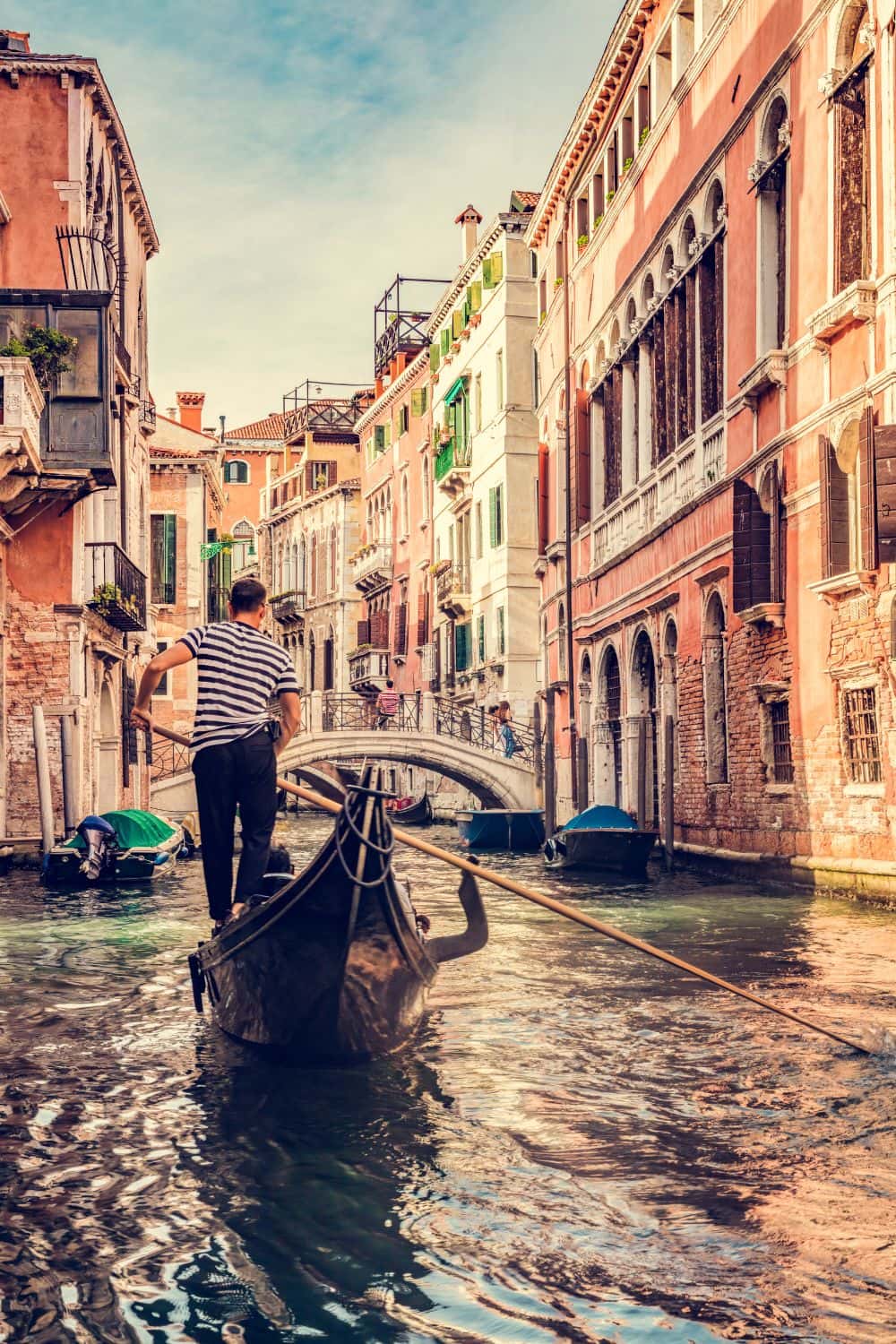
Venice, Italy / Venetian Gondoliers: Fascinating Insights into the Masters of the Canals
The esteemed tradition of gondoliers finds its roots in the annals of Venetian history, extending over a millennium.
The official birth of this vocation can be traced back to a historic license granted by Doge Vitale Falier in the year 1094.
In its infancy, the role of gondoliers predominantly revolved around serving the city’s noble Venetian families. These oarsmen were not just rowers but confidants entrusted with the closely guarded secrets of the aristocracy.
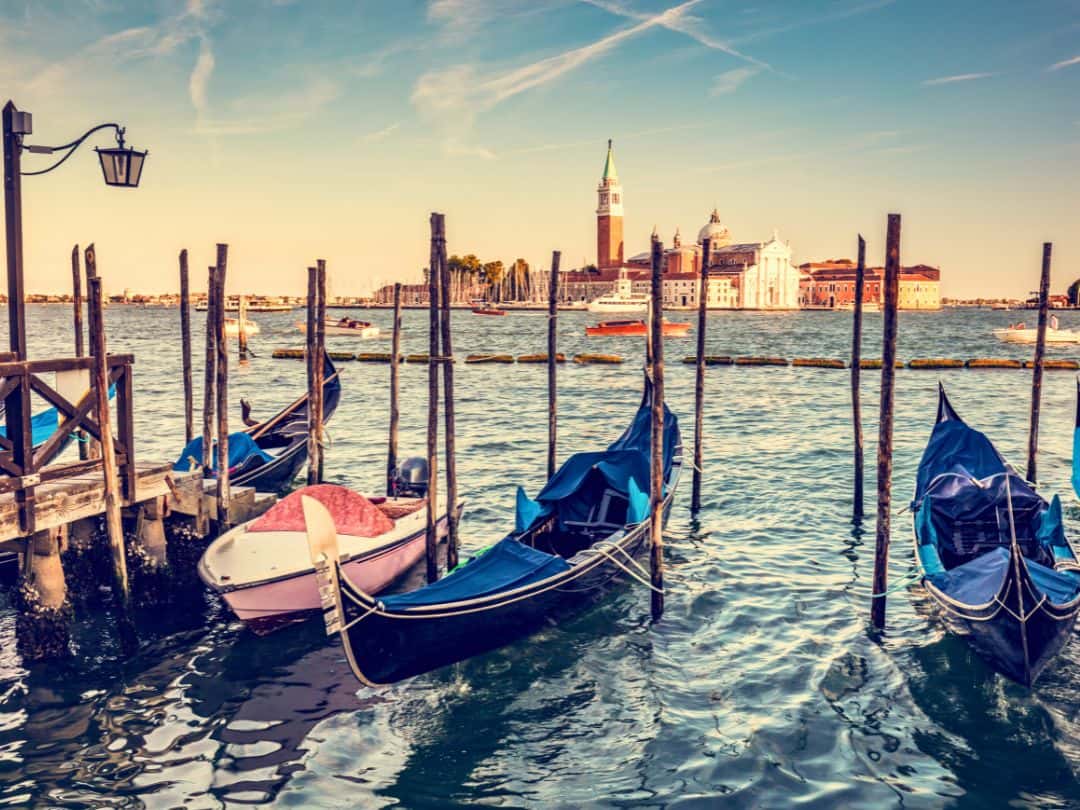
Venice, Italy / Venetian Gondoliers: Fascinating Insights into the Masters of the Canals
Throughout centuries, the profession of gondoliers evolved and adapted, shaped by the changing tides of Venice’s fortunes.
While their historical role was deeply intertwined with the aristocracy, today, gondoliers cater primarily to tourists from around the world.
The transition from serving the elite to sharing the enchantment of Venice’s waterways with visitors has preserved the essence of the gondolier tradition in a new, global context.
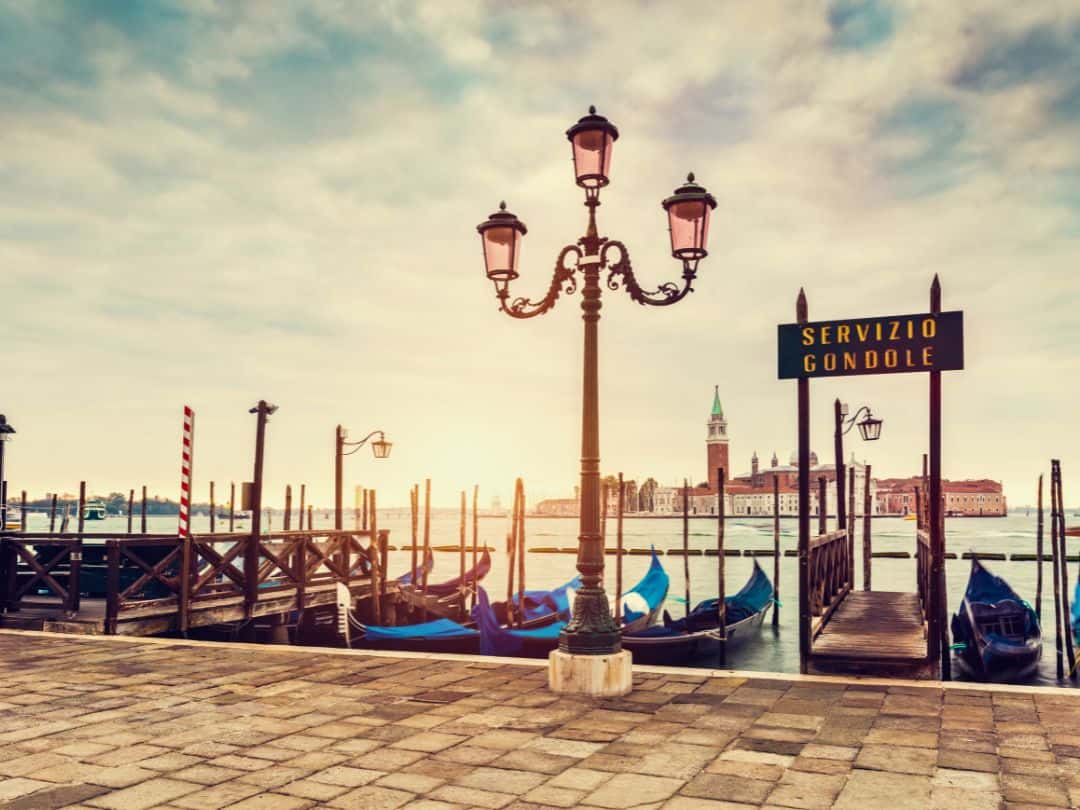
Venice, Italy / Venetian Gondoliers: Fascinating Insights into the Masters of the Canals
Within the world of gondolas, a sacred vow is upheld— “What happens on our Gondola, stays on our Gondola.”
This unspoken oath underscores the role of gondoliers as not just boatmen but as custodians of the stories whispered in the heart of Venice’s canals. Their legacy is intertwined with the mystique of the city, safeguarding its secrets as they navigate its waterways.
Becoming a Venetian Gondolier: A Rare and Exclusive Privilege
Becoming a Venetian gondolier is a rare and exclusive privilege, akin to navigating the intricate canals of Venice itself—reserved for the select few who hold the keys to the city’s aquatic heart.
This elite profession is not open to all; it demands a hereditary gondolier license, a prestigious emblem carefully transmitted from generation to generation.
The Hereditary Tradition
At the core of this enigmatic profession lies a deeply rooted tradition of hereditary succession.
For those unfamiliar with the intricacies of gondolier lineage, it is a fascinating story in itself!
The hereditary gondolier license, which I often think of as a “silver spoon in one’s mouth,” is more than just a piece of paper. It represents a legacy, a connection to Venice’s past that stretches back centuries.
This sacred license is passed down from father to son, or if there is no male heir, to another deserving male family member.
It is a tradition that underscores the exclusivity and preservation of the gondolier’s art, ensuring that only those deeply entrenched in the city’s culture can carry forward this remarkable profession.
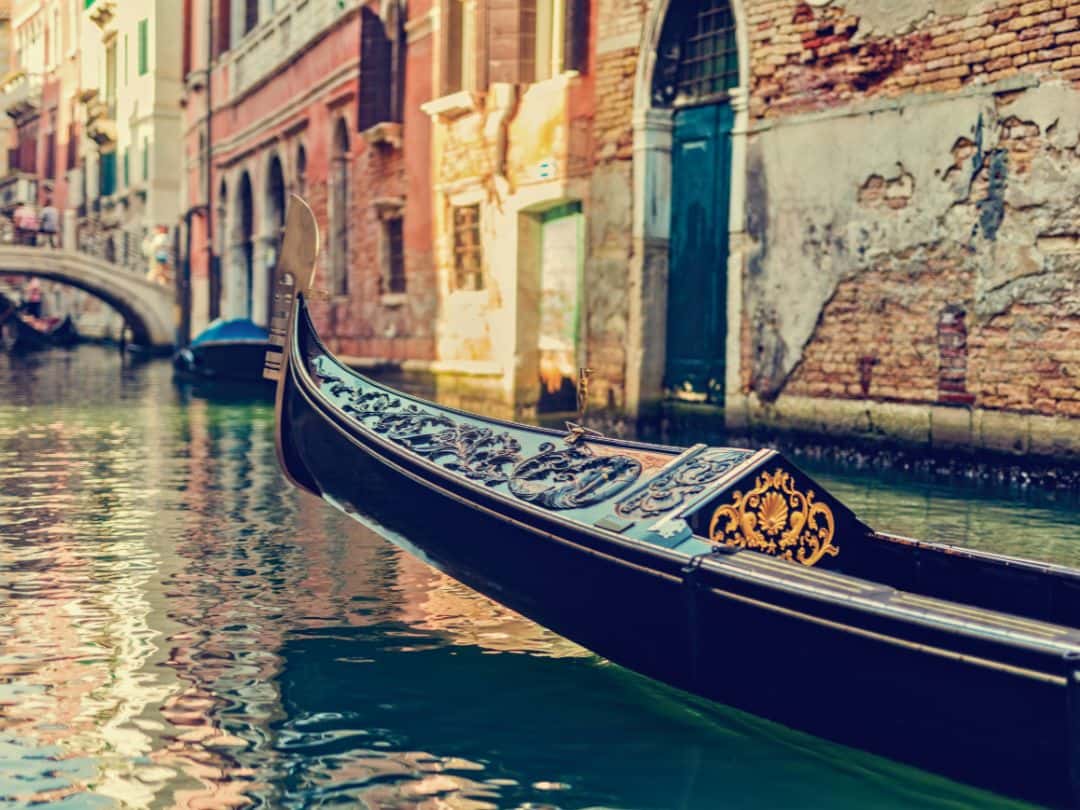
Venice, Italy / Venetian Gondoliers: Fascinating Insights into the Masters of the Canals
Yet, questions linger: What if a gondolier has no male heirs to carry on this age-old legacy? The answer lies in the intriguing possibility that the license can be sold, opening the door for outsiders to enter this exclusive world.
However, do not let this apparent openness fool you. The license is not available to just anyone; it is an exclusive privilege, granted only to those within the gondolier caste—relatives, the lifted ones, and the found ones.
In essence, one must still navigate the labyrinth of gondolier heritage to lay claim to this coveted license.
The School of Excellence
Beyond heritage and tradition, there is another crucial aspect to the journey of becoming a gondolier—the educational component.
Aspiring gondoliers embark on a path that leads them to The Institute for Protecting the Gondola and the Rights of the Gondoliers.
This revered institution is where the chosen ones refine their rowing skills to perfection. It is where they learn the art of navigating Venice’s intricate waterways and understanding the nuances of tides, currents, and the labyrinthine canal system.
Here, they also immerse themselves in the rich history of Venice, committing its stories and legends to memory. But it does not stop there; mastering the English language is a crucial part of their education, ensuring that they can communicate effectively with visitors from around the world.
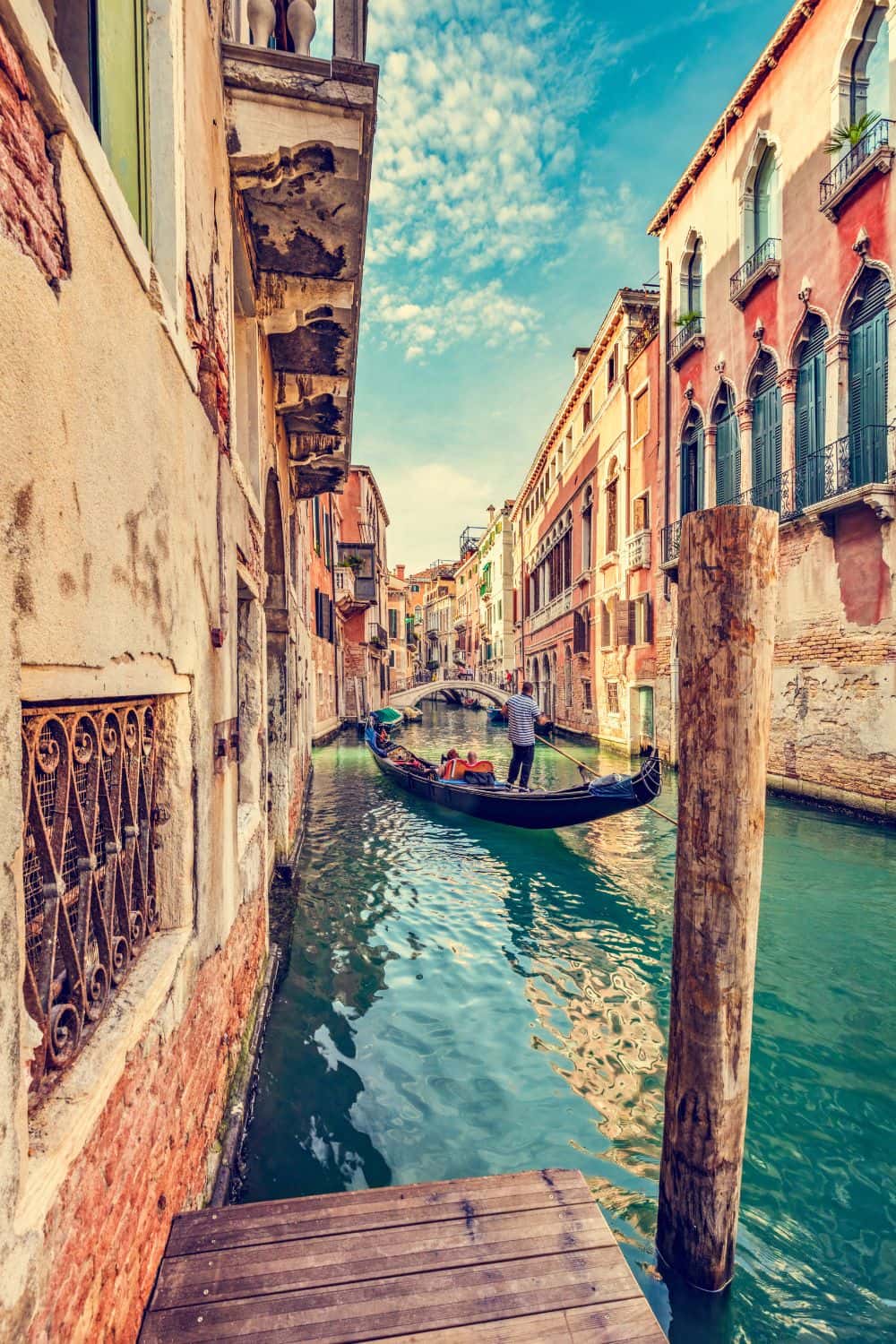
Venice, Italy / Venetian Gondoliers: Fascinating Insights into the Masters of the Canals
Success at this prestigious institute is not merely celebrated; it is etched in history.
The names of successful graduates are not just names—they are beacons of pride for the entire gondolier community. These names are proudly published in the local newspaper, and each name is accompanied by a notation: ‘son of’ or ‘brother of,’ underscoring the tight-knit bonds that form within the gondolier community.
It is a testament to the unity and camaraderie that define the world of Venetian gondoliers.
The Brotherhood of Gondoliers
Venice boasts 425 licensed gondoliers who are the custodians of this timeless craft, the navigators of the city’s soul.
They are the ones who gracefully glide through the canals, weaving tales of love and history with every stroke of their oars.
An additional 150 licensed ‘shift relief’ workers stand ready to carry the torch of tradition when needed.
Together, they constitute La Categoria—a 1000-year-old Gondolier Guild that has stood the test of time, preserving the essence of Venice’s waterways and upholding the legacy of the gondoliers. In the labyrinth of Venice’s canals, these masters of the craft are the guiding lights, the silent serenaders of love, and the guardians of tradition.
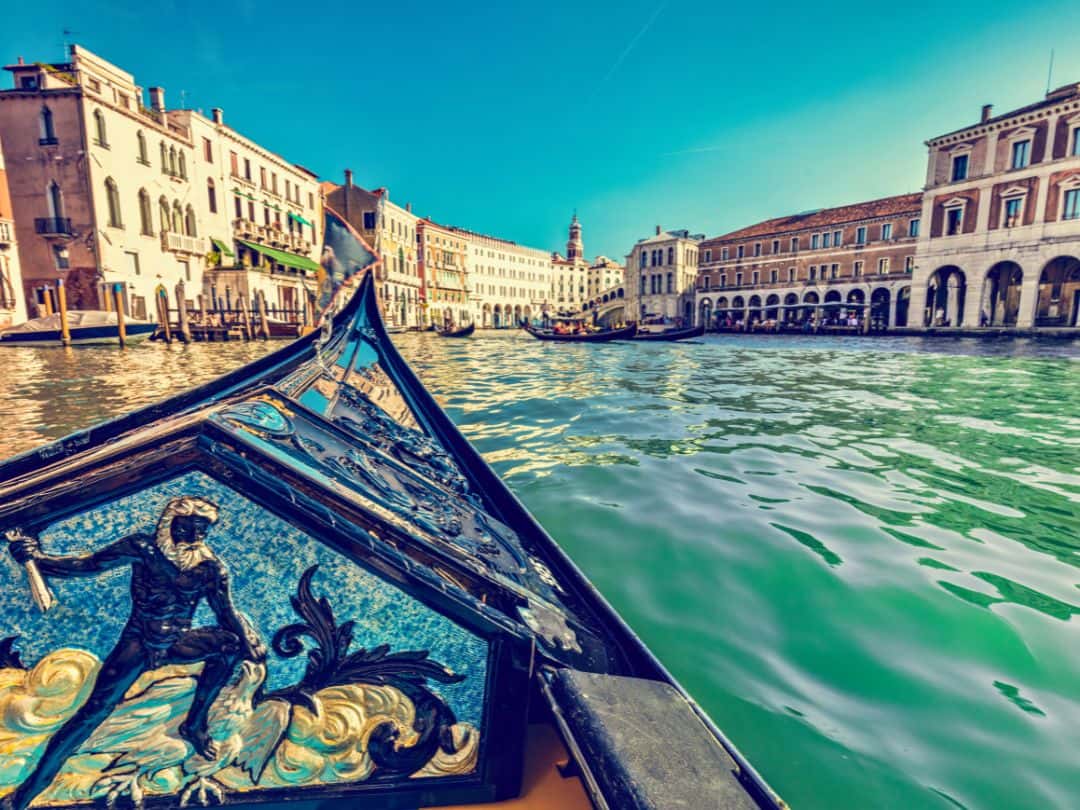
Venice, Italy / Venetian Gondoliers: Fascinating Insights into the Masters of the Canals
The Life Journey of a Gondolier: A Calling and Commitment to Venetian Traditions
Within the illustrious world of Venetian gondoliers, the path to becoming one of these revered oarsmen is a journey laden with tradition, skill, and an unwavering commitment to Venice’s aquatic legacy.
The Calling and Commitment
Becoming a gondolier is more than just a career choice; it is a calling, a destiny carved into the waterways of Venice itself.
Aspiring gondoliers embark on a unique journey, one that often begins with apprenticeships under experienced masters who have navigated these canals for generations.
This hands-on training is a rite of passage where skills are not just taught but absorbed, where the rhythm of the canals becomes second nature.
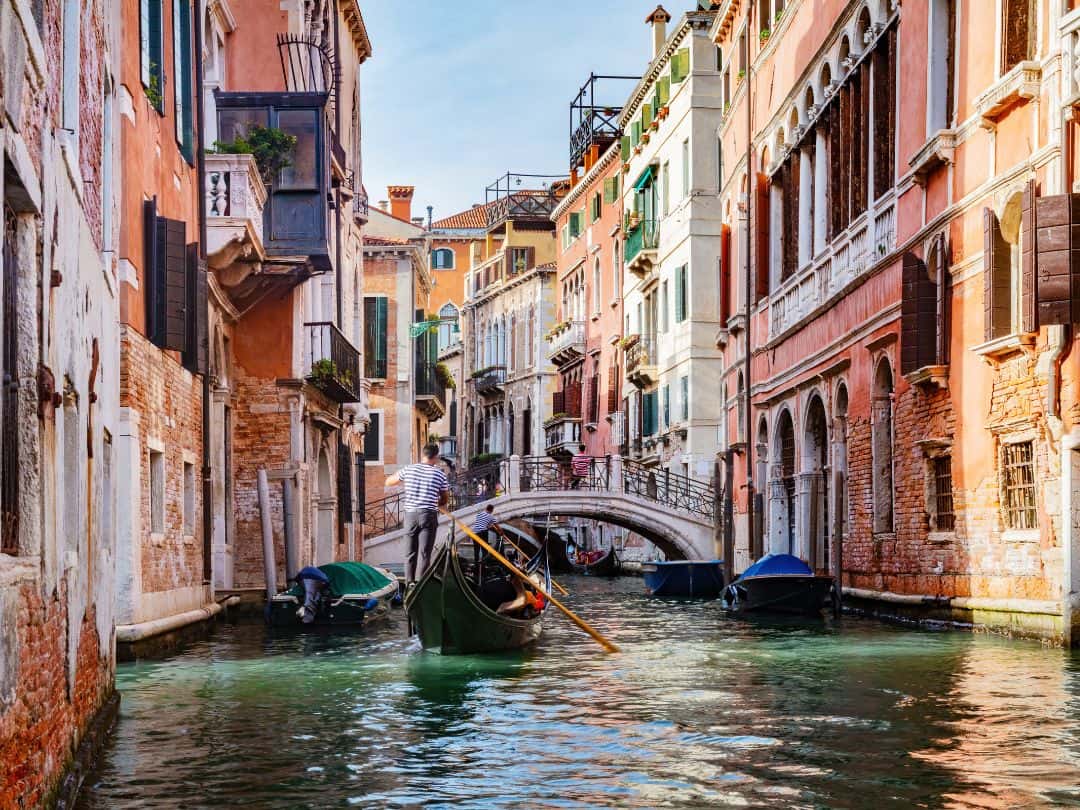
Venice, Italy / Venetian Gondoliers: Fascinating Insights into the Masters of the Canals
At the heart of a gondolier’s craft lies their mastery of the oar. It is not just about propelling a boat; it is an intricate dance between the gondolier, the boat, and the canals.
Navigating these waterways requires an innate sense of balance and rhythm, harmonizing movements with the gentle sway of the gondola. This is a skill that can only be honed through years of dedicated practice.
Navigating the Venetian canals is an art in itself! These waterways are not just picturesque; they are dynamic, demanding constant attention.
Gondoliers must develop an understanding of the tides, the currents, and the subtleties of the lagoon. They must navigate under low bridges, deftly steer clear of other boats, and guide their passengers safely through the narrow passages that define Venice’s unique waterborne culture.
Yet, being a gondolier is not just about mastering the art of rowing; it is about preserving the customs, attire, and etiquette that define Venetian gondolier culture.
They are entrusted with upholding a legacy that stretches back for centuries. Their role extends beyond ferrying passengers; they are the torchbearers of tradition.
The Iconic Attire of Venetian Gondoliers
The attire of a Venetian gondolier is a striking ensemble that transcends mere clothing—it is a visual manifestation of history, tradition, and cultural identity. Each element of their outfit serves as a symbol and a connection to the unique world of the gondolier.
The Evolution of the Venetian Gondolier Uniform: From All Black to Stripes
The striking red or blue striped shirt, paired with a straw hat, stands as one of the most globally recognizable uniforms.
However, the outfit did not always feature these iconic stripes. In the early days of the gondola, when many gondoliers were Moorish slaves, black attire was the norm to match the color of their boats.
Some even favored all-white ensembles.
The transition to the now-famous striped shirt occurred post-World War II, yet the origins of these stripes remain veiled in mystery. Two prevalent theories suggest inspiration from the striped poles lining the Grand Canal or the practicality dictated by the French Navy, which mandated stripes for enhanced safety.
For those captivated by this Venetian tradition, acquiring a gondolier shirt serves as a meaningful gesture of support. These shirts can be found at the Emilio Ceccato clothing store, nestled at the foot of the Rialto Bridge, or through online avenues.
Each purchase contributes to endeavors dedicated to conserving the gondolier profession and the artisanal traditions intertwined with the gondola and Venetian rowing styles.
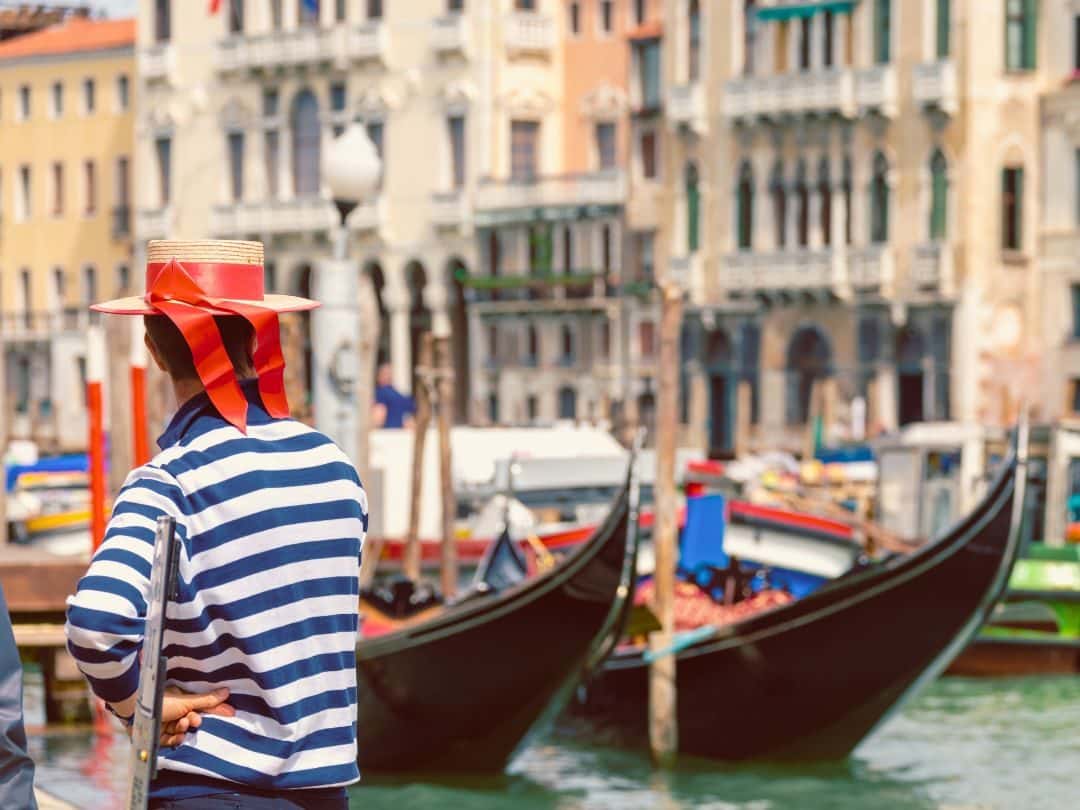
Venice, Italy / Venetian Gondoliers: Fascinating Insights into the Masters of the Canals
The Straw Hat with a Ribbon and the Furlane Shoes
One of the most distinctive features of a gondolier’s attire is their straw hat, gracefully adorned with a ribbon.
This hat serves both practical and symbolic purposes. Its wide brim provides essential shade as gondoliers navigate the sun-kissed canals of Venice. The ribbon, often bearing the colors of Venice’s flag, is a testament to their allegiance to the city’s unique identity.
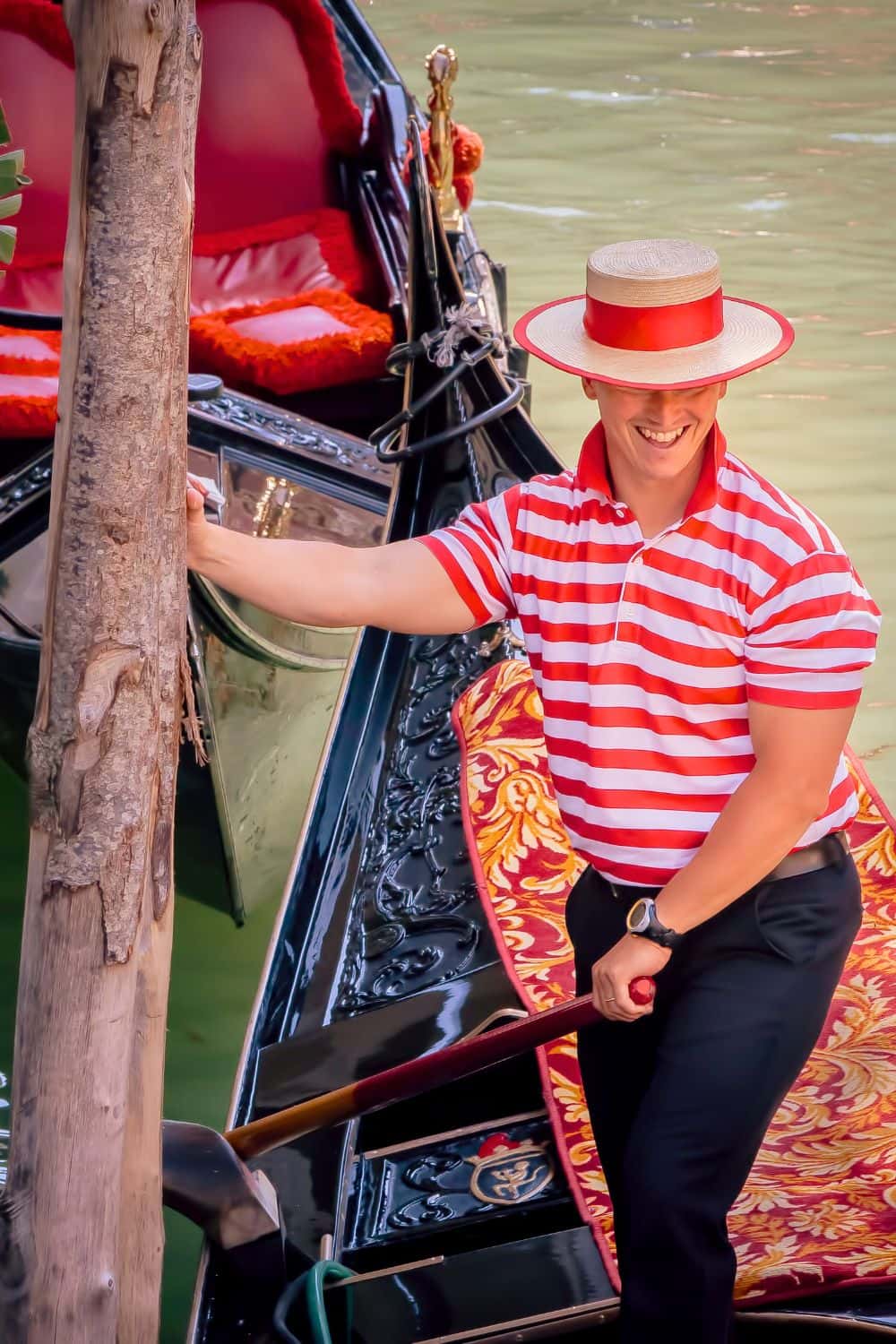
Venice, Italy / Venetian Gondoliers: Fascinating Insights into the Masters of the Canals
Completing the gondolier’s ensemble are the furlane shoes—simple yet functional footwear, typically made from black velvet or fabric. These unpretentious shoes are designed for practicality, providing sure footing on the often-slippery decks of the gondola.
However, they are also imbued with a sense of tradition, symbolizing the unbroken connection between the gondolier and their craft.
A Living Tradition
Every time a gondolier dons this iconic attire, they become a living embodiment of Venice’s history and culture.
They carry the weight of centuries on their shoulders, paying homage to the city’s maritime legacy and its enduring allure.
The attire is more than just clothing; it is a symbol of identity and a testament to the gondolier’s dedication to preserving the essence of Venice’s romantic canals.
The Intricate Structure of Venetian Gondolas
The Venetian gondola, a timeless and emblematic vessel, is a testament to craftsmanship, symbolism, and practicality.
In this section, we will delve deeper into the remarkable details that define the gondola’s unique structure.
Venetian Gondola Design and Craftsmanship
The Venetian gondola stands as a timeless masterpiece of naval architecture.
Its long, slender silhouette, measuring approximately 10.85 meters in length and 1.44 meters in width, is instantly recognizable. This design, combining grace with functionality, allows for smooth navigation even in the shallow waters of the lagoon.
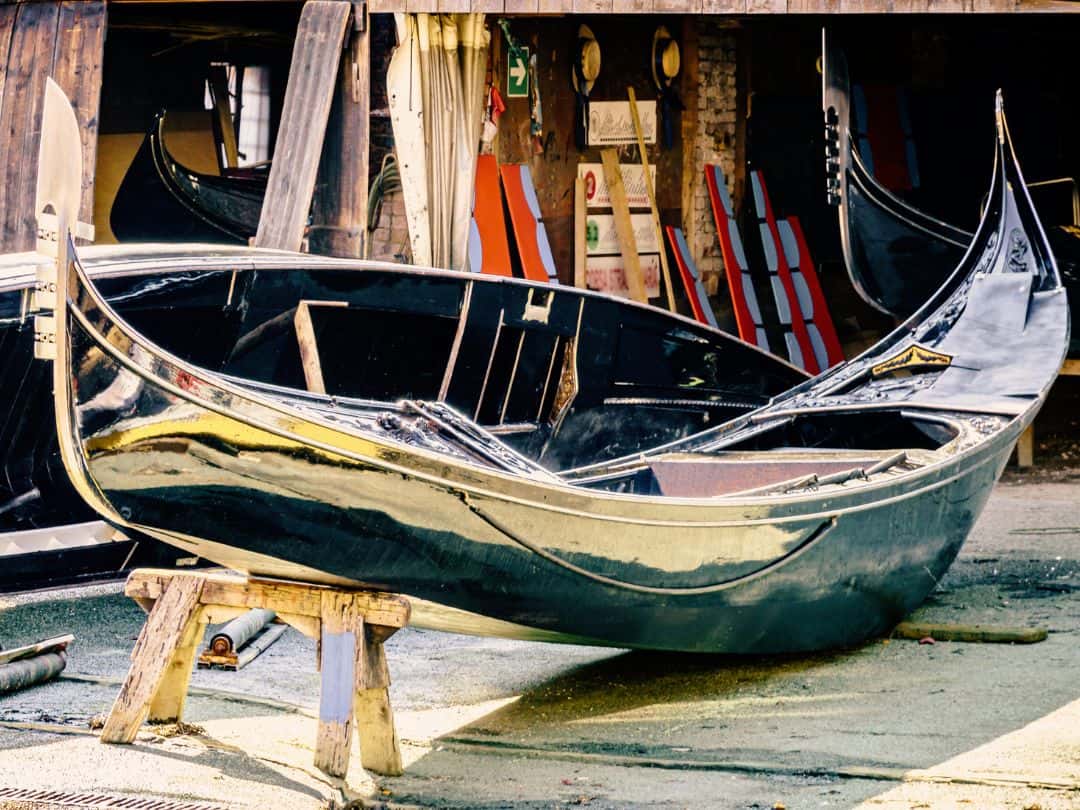
Venice, Italy / Venetian Gondoliers: Fascinating Insights into the Masters of the Canals
One of the most intriguing aspects of the gondola’s design is its asymmetry. The bottom of the gondola is intentionally crafted to be uneven. This clever asymmetry serves a crucial purpose—balancing the weight of the gondolier, who stands on one side.
It is a testament to the ingenuity of Venetian boat builders that such a subtle feature can have a profound impact on the vessel’s stability and maneuverability.
Gondolas are crafted from a selection of eight different types of wood, each carefully chosen for its unique properties.
Oak, larch, fir, linden, elm, walnut, mahogany, and cherrywood all play a role in the gondola’s construction. This diversity of wood types ensures the boat’s durability, resilience, and overall excellence.
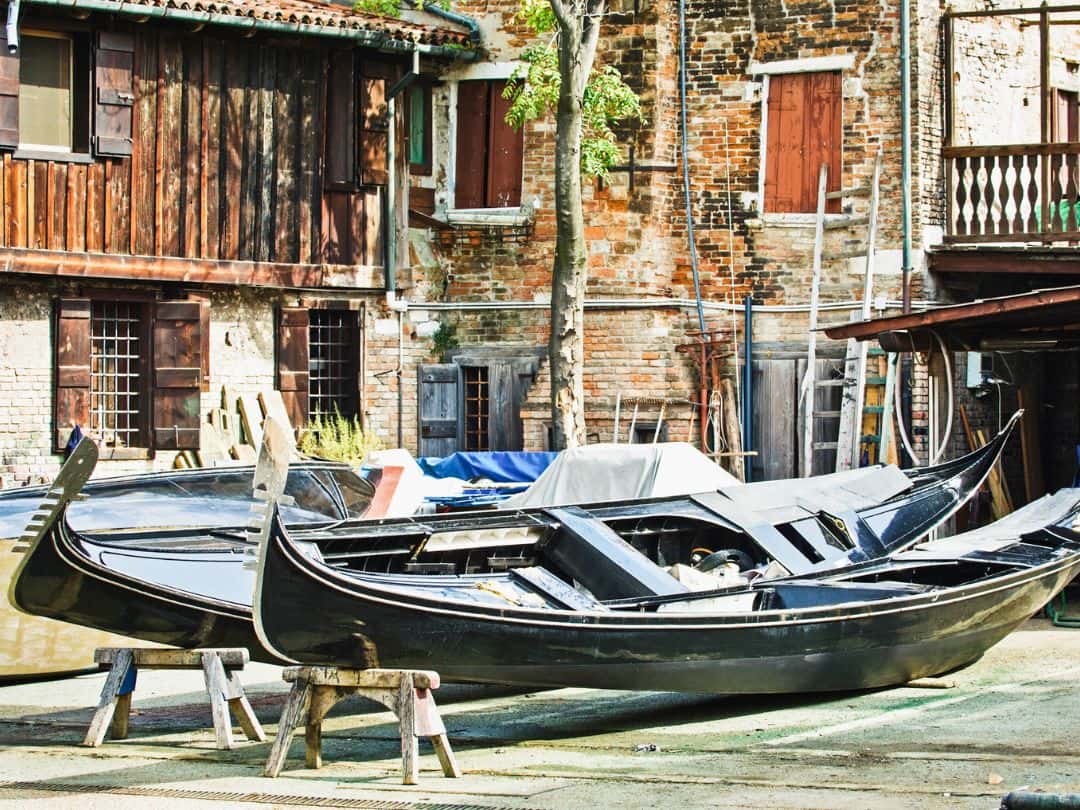
Venice, Italy / Venetian Gondoliers: Fascinating Insights into the Masters of the Canals
The crafting of a gondola is a laborious and meticulous process, involving a team of skilled artisans.
The heart of this craftsmanship takes place in the “squero,” the traditional Venetian craftsman’s workshop. Among these artisans are the “squeraiol,” the esteemed master carpenters who meticulously shape the wooden hull.
Additionally, the “Battiloro,” or goldsmith, contributes intricate gold decorations, while the blacksmith meticulously forges the gondola’s iron prow-head by hand.
The Legacy of Black Venetian Gondolas
The gondola’s distinctive black color carries historical and aesthetic significance.
Before the decree of 1609, private gondolas were flamboyantly adorned with bright colors and patterns, reflecting the extravagance of the time.
However, the decree mandated that gondolas must be painted exclusively in black. This regulation, apart from introducing an element of elegance, was also practical since the pitch used for waterproofing was also black.
Today, the opulence of a gondola is often determined by the amount of real gold leaf used for decoration, with the most ornate gondolas reserved for special occasions and ceremonies.
Symbolic Prow-Head of Venetian Gondolas
The front section of the gondola, known as the “bow iron” or prow-head, is not a mere decorative piece; it carries profound symbolism in its design:
- The six metal lines symbolize Venice’s six Sestieri (districts).
- The rear-facing tooth shape is a nod to the Giudecca island area.
- The ubiquitous “S” shape throughout represents the iconic Grand Canal and the famous Rialto Bridge.
- The upper part of the iron takes the shape of the Doge’s hat.
- In some artistic renditions, three leaves are added, representing the celebrated islands of Murano, Burano, and Torcello within the lagoon.
The prow-head is not just about aesthetics; it encapsulates the essence of Venice itself, and blacksmiths follow age-old traditions in its creation.
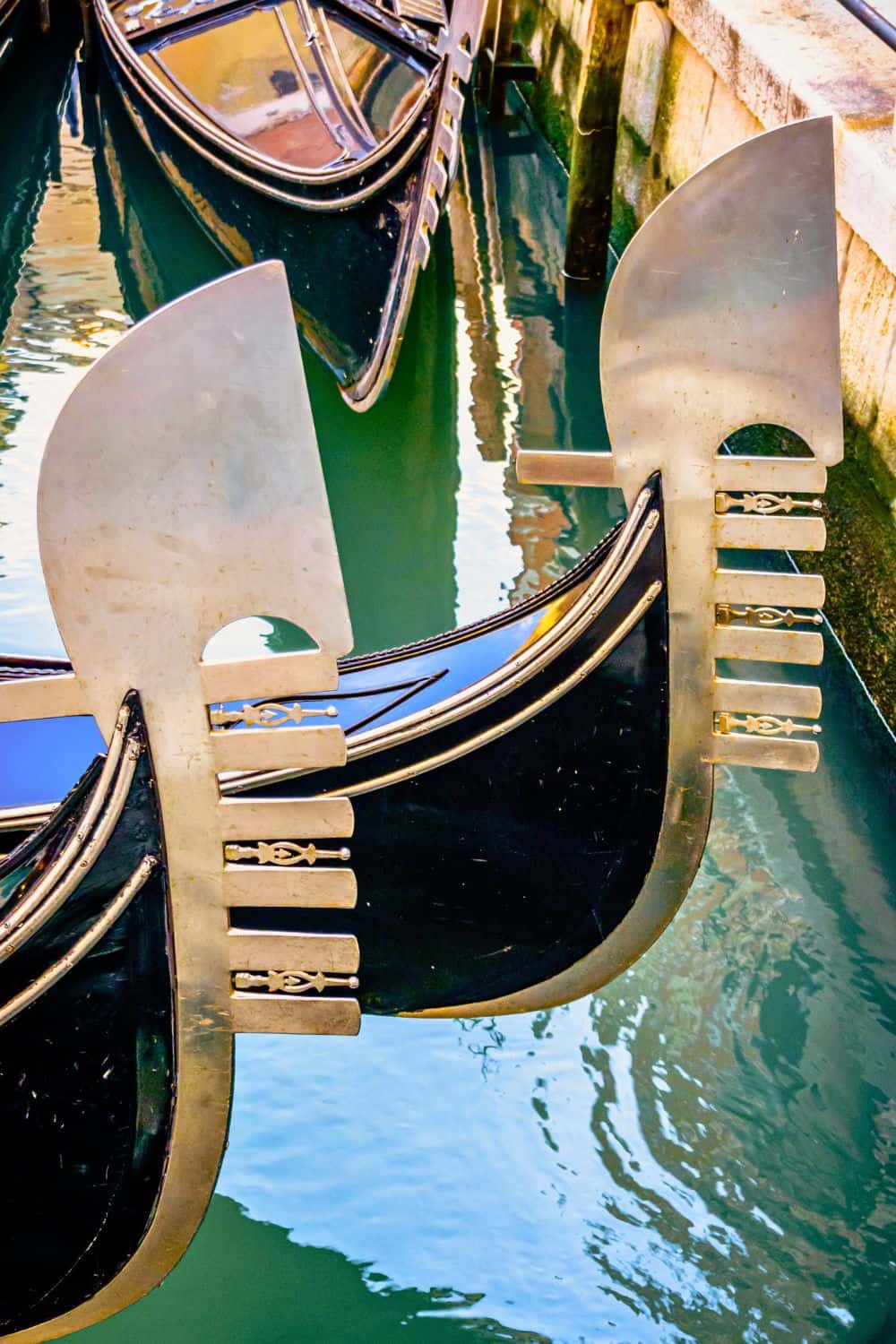
Venice, Italy / Venetian Gondoliers: Fascinating Insights into the Masters of the Canals
Gondola Etiquette
When preparing to board a Venetian gondola, it is imperative to heed the gondolier’s instructions, especially when it comes to seating arrangements.
Given the gondola’s asymmetrical design, shifting weight or changing seats can disrupt the delicate balance and even pose a risk of capsizing the boat.
PRO TIPS: If you are planning to book your Venetian gondola experience, I have a few tips for you:
- Book Online: Simplify your gondola ride by booking it online in advance. This eliminates the need for negotiating prices and ensures a smoother experience.
- Choose a Private Tour: Opt for a private gondola tour to enjoy an intimate and personalized experience. Sharing your gondola with only your companions enhances the romantic atmosphere.
- Add a Serenade: Elevate your journey by including a serenade during your gondola ride. This musical touch adds an extra layer of enchantment, creating unforgettable memories of your time in Venice.
Following are two gondola ride experiences that I am recommending:
Romantic Private Gondola Ride on Grand Canal – private gondola ride down the Grand Canal. You will glide past iconic landmarks and turn into romantic side canals as your gondolier rows gondola through Venice’s beating heart.
Private Tour: Venice Gondola Ride with Serenade – here you will embark on a quintessential Venetian experience with a private, serenaded gondola ride through the famed canals of Venice. Glide past ancient palazzi and magnificent cathedrals on a traditional handcrafted gondola, while musicians serenade you with mood-setting Italian ballads.
Giorgia Boscolo's Historic Admission to the Gondolier School
In the traditionally male-dominated realm of Venetian gondoliers, a beacon of change shone through Giorgia Boscolo’s remarkable journey.
As the sole descendant of the illustrious Boscolo clan, Giorgia achieved a groundbreaking milestone when she gained admission to the hallowed halls of the gondolier school.
Her unwavering determination and unrelenting dedication propelled her through the rigorous exams, culminating in the attainment of her father’s coveted license.
Giorgia’s journey marked a pivotal moment in Venetian history, as she shattered the time-worn gender barrier that had defined the profession for centuries.
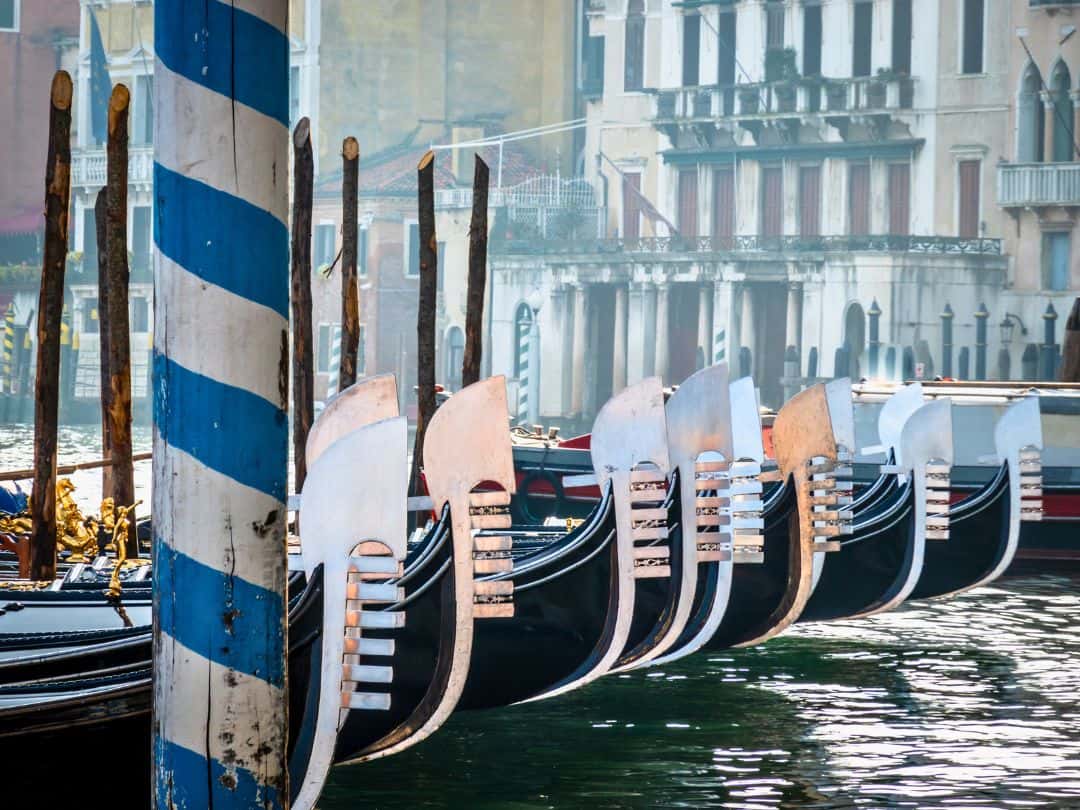
Venice, Italy / Venetian Gondoliers: Fascinating Insights into the Masters of the Canals
Giorgia’s remarkable achievement, while groundbreaking, came with its own set of limitations. She could serve as a shift relief worker but was denied the status of a full-fledged gondolier.
Despite this, her story resonates as a symbol of progress and resilience in the face of tradition. Giorgia’s determination to make her mark on the gondola-laden waters of Venice serves as a testament to the evolving landscape of this ancient profession.
Giorgia Boscolo’s journey stands as a pivotal milestone, yet the quest for gender equality among Venetian gondoliers remains an ongoing battle.
The tightly knit and tradition-bound gondolier community grapples with the challenge of adapting to a more inclusive future.
While Giorgia’s story has swung the doors of opportunity ajar, it also underscores the obstacles and resistance encountered on the path toward a more balanced representation in this age-old profession. Her legacy ignites hope for future generations of women who dare to dream of navigating Venice’s enchanting canals and bridges.
The Art of Gondola Rowing
The Distinctive Rowing Style: Voga alla Veneta
The voga alla veneta rowing style, often referred to simply as “voga,” is the heartbeat of gondoliering, a technique as unique as the city of Venice itself.
This centuries-old rowing style is a testament to the adaptability and innovation of the gondoliers who navigate the city’s complex waterways daily.
Here, we delve deeper into the intricate art of voga alla veneta:
- Standing Tall: Gondoliers stand upright at the stern (the back) of the gondola, a stance that sets them apart from rowers in most other parts of the world. This distinctive posture allows them to see ahead clearly, which is essential for navigating Venice’s narrow and congested canals.
- Single-Oar Mastery: Unlike rowers who use two oars, gondoliers expertly wield a single oar, known as the “remo,” with exceptional skill. The asymmetrical shape of the gondola, with its flat bottom, demands a unique rowing technique. The gondolier maneuvers the oar through the water with precision and grace, propelling the boat forward.
- Silent Symphony: The voga style of rowing is as much about the rhythm and harmony of movement as it is about propulsion. Gondoliers coordinate their strokes in a seamless manner, ensuring a smooth and silent glide through the serene waters of Venice. This synchronized rowing technique adds to the city’s tranquil ambiance.
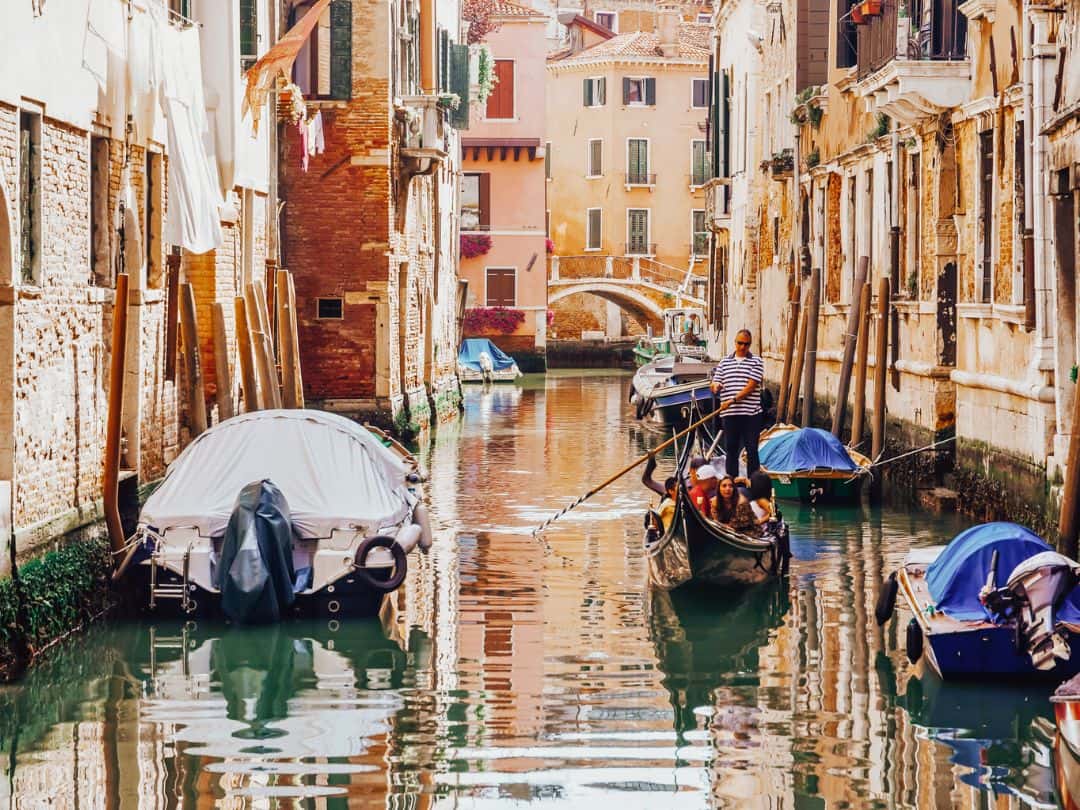
Venice, Italy / Venetian Gondoliers: Fascinating Insights into the Masters of the Canals
Navigating the Canals: The Role of the Forcola
At the heart of this exquisite rowing style lies the forcola, a meticulously crafted wooden component that can be considered the gondola’s “steering wheel” and “rowlock” combined. This ingenious piece of craftsmanship plays a pivotal role in the voga alla veneta technique and the gondolier’s ability to navigate Venice’s intricate canal network:
- Forcola Design: The forcola is hand-carved from solid walnut or cherry wood, showcasing the artisanal skills passed down through generations. Each forcola is a unique work of art, designed to fit the specific needs and preferences of the gondolier who uses it.
- Flexibility and Precision: The forcola’s design allows for flexibility and precision in rowing. Its unique curves and notches enable the gondolier to adapt their oar strokes to the ever-changing conditions of the Venetian canals. This adaptability is essential for smoothly maneuvering through narrow passages and avoiding obstacles.
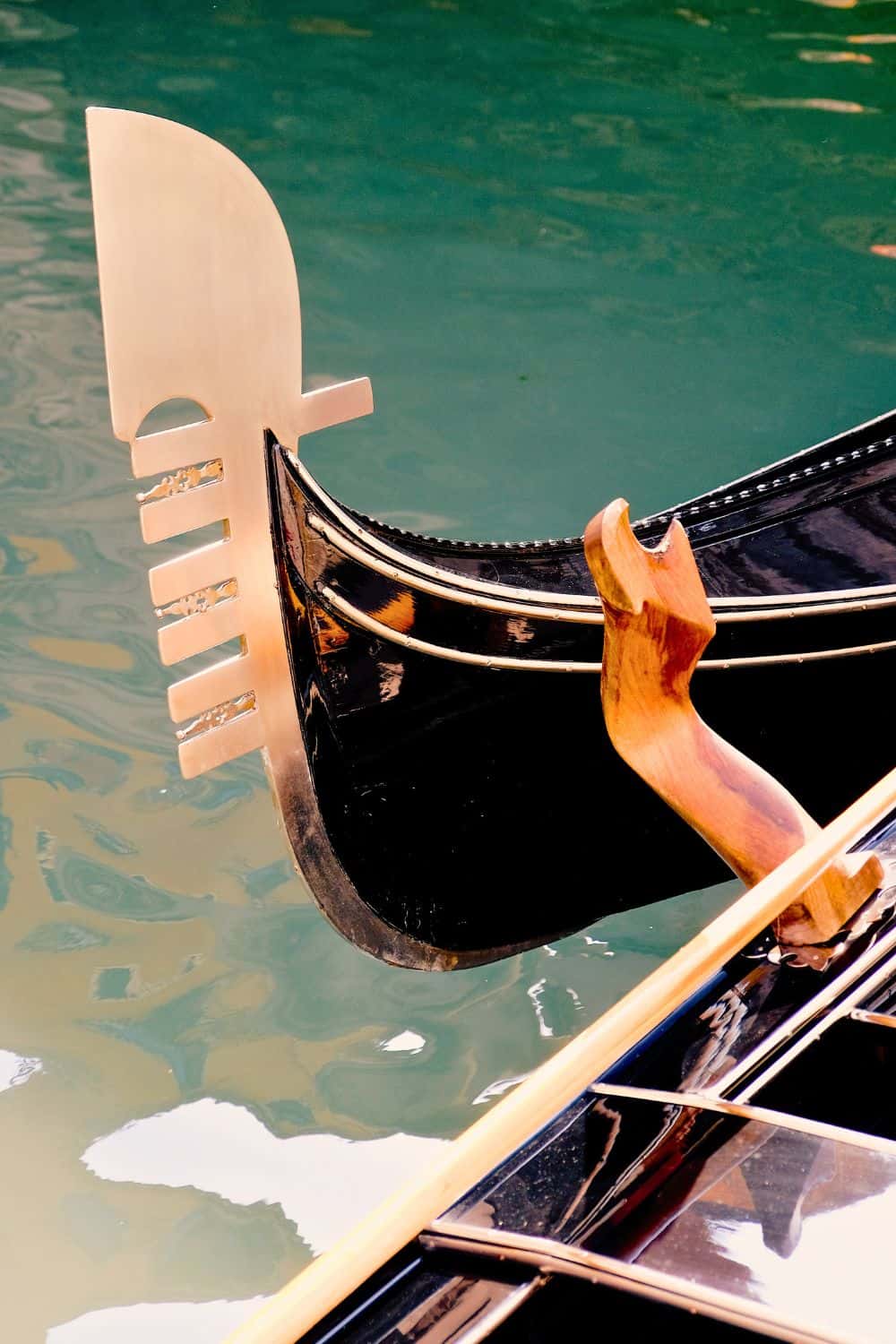
Venice, Italy / Venetian Gondoliers: Fascinating Insights into the Masters of the Canals
- Mastering the Forcola: Becoming proficient in using the forcola is a long and arduous process. Gondoliers must train rigorously to develop the dexterity required to manipulate the oar effectively. This training often includes learning various rowing techniques and understanding the nuances of the forcola’s design.
- Preserving Tradition: The forcola is not just a functional tool; it’s a symbol of Venetian heritage and the craftsmanship that has defined the gondolier profession for centuries. As gondoliers row their passengers along the canals, the forcola serves as a physical connection to the city’s rich history and enduring traditions.
These insights into the voga alla veneta rowing style and the significance of the forcola offer a glimpse into the artistry and precision that define the world of Venetian gondoliers. It’s a world where the past and present converge seamlessly, creating an experience that continues to enchant visitors from around the world.
The Gondolier's Songs
One of the most captivating and immersive elements of a gondola ride in Venice is the timeless tradition of gondolier singing.
As the gondolier expertly maneuvers the boat through the labyrinthine canals, their rich, melodious serenades fill the air, enveloping passengers in a romantic and enchanting experience.
This tradition, deeply rooted in Venetian culture, is a testament to the gondolier’s unique role as both rower and entertainer.
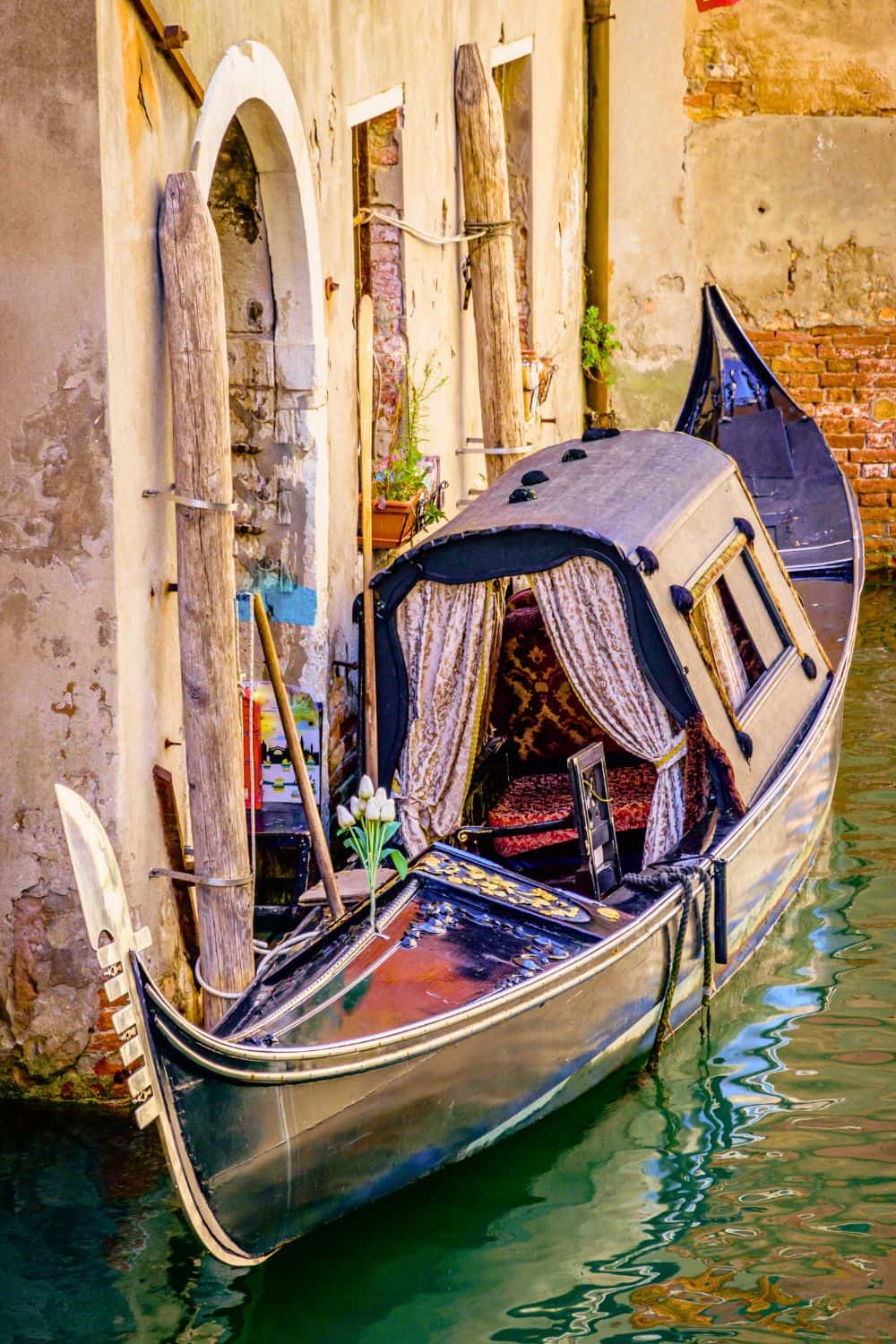
Venice, Italy / Venetian Gondoliers: Fascinating Insights into the Masters of the Canals
Gondolier songs, or “barcarole,” are more than just musical accompaniments to a scenic ride. They are an integral part of the Venetian gondola experience, imbuing each journey with emotion, history, and a sense of place.
Here, we explore the significance of these serenades and the themes that underpin them:
- Love and Romance:
A recurring theme in gondolier songs is love, particularly the profound, timeless kind that Venice itself embodies.
Gondoliers croon about the beauty of the city’s canals, the mesmerizing reflection of moonlight on the water, and the captivating allure of their passengers.
These romantic ballads transport riders into a world of passion and longing, where love knows no bounds.
- Odes to Venice:
Gondolier songs often pay tribute to the city they call home.
These odes celebrate the unique character of Venice, its rich history, and its enduring charm.
The lyrics capture the essence of the floating city, from its labyrinthine canals to its iconic architecture, offering passengers a deeper appreciation of the place they’re exploring.
Through their songs, gondoliers bridge the past and the present. They draw upon centuries-old musical traditions that have been passed down from one generation to the next. In doing so, they honor the legacy of their predecessors while creating new memories for their passengers.
Gondolier songs are a masterful blend of music and storytelling. The lyrics are often filled with raw emotion, allowing passengers to connect with the music on a profound level. Whether it’s the joy of newfound love or the melancholy of farewell, gondolier songs evoke a range of feelings that linger long after the ride has ended.
Examples of famous gondolier songs include “Santa Lucia,” a beloved Neapolitan song that pays homage to the picturesque Santa Lucia district in Venice.
Another classic is “O Sole Mio,” an ode to the radiant Venetian sun that bathes the city in a golden glow. These songs, and many more, are woven into the fabric of Venetian culture, creating a soundtrack that accompanies every gondola journey.
As passengers float along the canals, serenaded by the melodies of gondoliers, they become part of a centuries-old tradition that seamlessly blends music, love, and the incomparable beauty of Venice. These songs are not merely performances; they are the heart and soul of gondola rides, turning each voyage into a symphony of emotions and memories.
Romance on the Canals: Gondola Rides in Venice
- Musical Serenades:
Many couples choose to enhance their gondola experience with live music. Gondoliers, often skilled musicians, may serenade passengers with love songs or traditional melodies. The soothing rhythm of the oar and the melodic tunes elevate the romantic atmosphere, making it a memory to cherish.
- Sunset and Moonlight Rides:
The timing of a gondola ride can significantly influence the romantic experience. Sunset and moonlight rides are particularly popular, as they infuse the journey with a warm, golden glow or the enchantment of a starlit sky. These moments are perfect for sharing stories, whispering sweet nothings, and creating lasting memories.
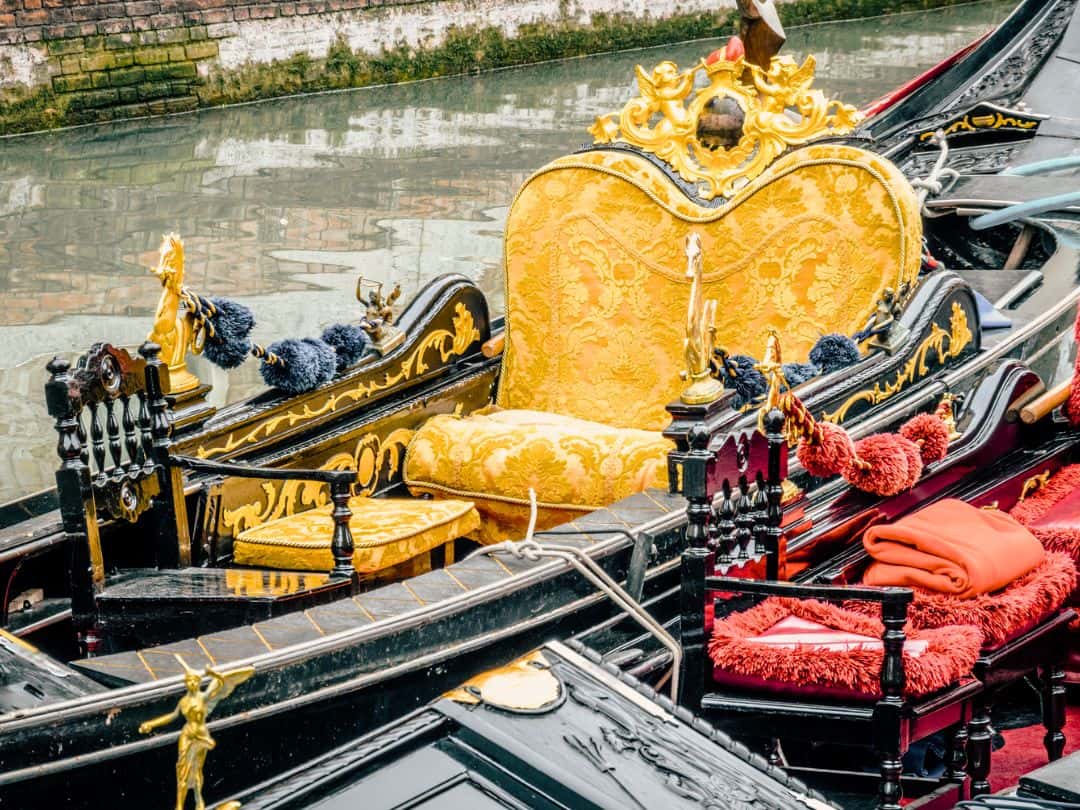
Venice, Italy / Venetian Gondoliers: Fascinating Insights into the Masters of the Canals
The canals of Venice have been the backdrop for countless love stories, each as unique as the couples who embark on these romantic voyages.
Gondola rides often serve as the setting for unforgettable moments:
- Proposals Under Iconic Bridges:
Venice’s bridges, such as the renowned Bridge of Sighs, are often chosen as the perfect location for marriage proposals. Gondoliers discreetly navigate their boats beneath these historic landmarks, allowing couples to embrace the timeless beauty of Venice as they pledge their love.
- Intimate Moments Shared:
Gondola rides offer couples a rare opportunity to escape the bustling crowds and savor moments of intimacy and togetherness. The gentle swaying of the boat, the sound of the oar slicing through the water, and the romantic backdrop of Venice’s architecture combine to create an ambiance that fosters connection and affection.
Gondoliers: Silent Witnesses to Romance
Gondoliers, beyond their role as skilled navigators, often serve as silent witnesses to the tender moments shared by couples on their boats.
Their professionalism and discretion ensure that each romantic voyage is as private and intimate as the passengers desire.
Whether it is a newly engaged couple celebrating their love or seasoned partners rekindling their connection, gondoliers play an essential part in preserving the magic of Venetian romance.
Venice’s gondoliers are well-versed in the customs of romance on their boats. They understand the significance of these moments to couples, and they strive to make each ride as memorable as possible:
- Offering Privacy: Gondoliers respect the privacy of their passengers, allowing couples to bask in their shared moments without intrusion. They navigate routes that provide tranquility and seclusion.
- Enhancing the Atmosphere: Many gondoliers provide additional touches to enhance the romantic ambiance, such as soft lighting, fresh flowers, or even champagne. These thoughtful gestures elevate the experience.
- Sharing Local Lore: Gondoliers often double as unofficial tour guides, sharing intriguing stories and tidbits about the city’s history, culture, and legends. This not only enriches the journey but also adds depth to the romantic experience.
Ultimately, a gondola ride in Venice is not just a boat trip; it’s a journey through history, art, and love. With gondoliers as their guides, couples have the opportunity to create their unique stories of romance amid the timeless beauty of Venice’s canals.
Lessons from Venice's Canals - My Gondola Rowing Experience
Gondola rides in Venice are truly exceptional, earning a perfect 10 out of 10 on the experience scale. Rowing your own gondola is an extraordinary bucket-list adventure that offers unique insights into this timeless tradition.
Have you ever wondered what it’s like to stand at the back of a gondola, wielding an oar with the grace of a Venetian maestro? Allow me to paint you a vivid picture:
- The Voga alla Veneta Rowing Style:
First of all, what you need to know is that at the heart of the gondolier experience lies the voga alla veneta rowing style, a technique as distinctive as Venice itself. It involves standing upright, facing forward, and harmonizing with the rhythmic flow of Venetian waters. This unique style was developed to navigate the city’s intricate canal system and bustling commerce.
The tight and bustling waterways demanded a clear view for the vagatore, the rowing master, hence the need to stand and face forward. The central space of the gondola was kept free, either for cargo or passengers, making the vagatore’s position at the rear indispensable.
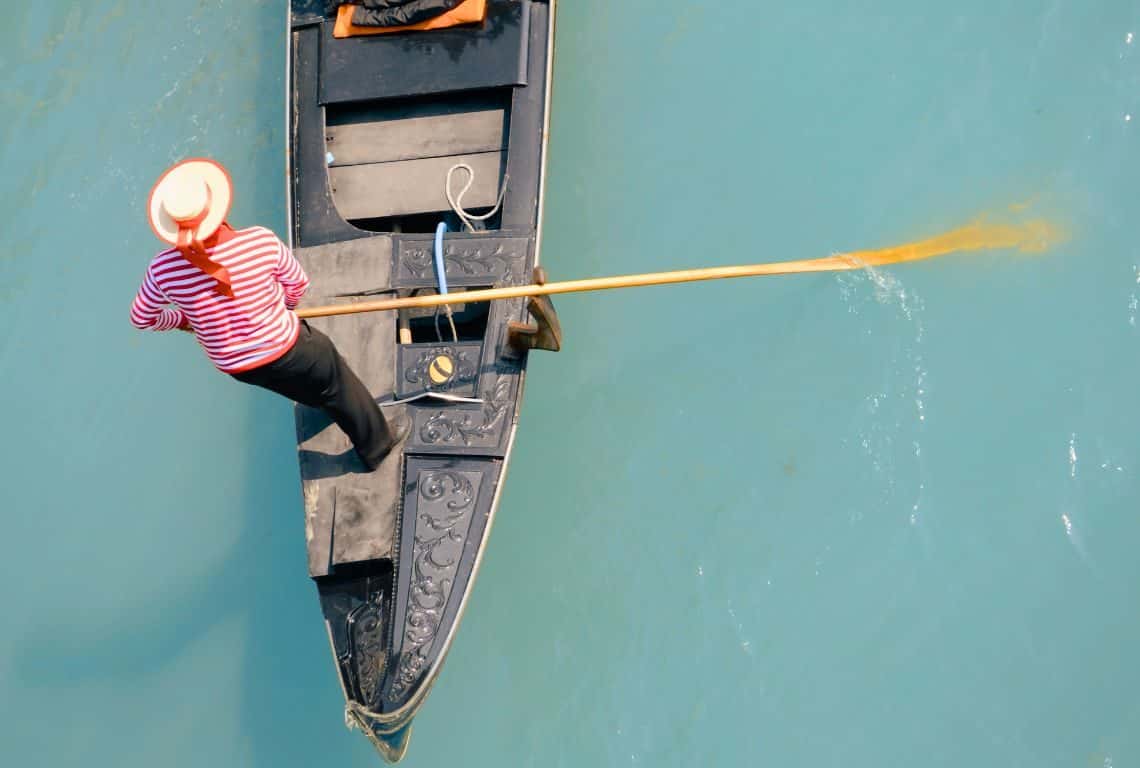
Venice, Italy / Venetian Gondoliers: Fascinating Insights into the Masters of the Canals
- The Challenges of Learning How to Navigate a Gondola:
My instructor, the consummate cool cat of the canals, imparted his wisdom. “Stand tall, chest out, and shoulders back,” he advised.
The gondola, measuring an impressive 35 feet 6 inches in length, offered some reassurance.
It was the oar that presented the real challenge – a formidable 13-foot length of unwieldy wood. The oar must be deftly kept in its forcole, the boat’s elbow-like rowlock or “cradle.”
The forcoles are meticulously carved from solid walnut or cherry wood, each designed to facilitate a range of strokes mastered by an accomplished vagatore.
I found myself striving for balance, legs slightly apart, as I pushed against the tranquil waters of Venice. The oar dipped and rose, occasionally eluding the grasp of its forcole.
At that point, we remained motionless, and my instructor encouraged me to feel the tide through the oar’s touch.
I closed my eyes, letting my imagination carry me into the world of the vagatore. With balletic grace and precision, I envisioned navigating the labyrinthine channels, ducking under ancient bridges, and gracefully dodging other gondolas and motorboats, all while tending to up to six curious tourists.
Summoning my courage, I puffed out my chest and squared my shoulders. With renewed determination, I dipped the oar back into the water, and this time, my stroke was firmer and more confident. The oar obediently remained in its forcole, and the gondola began to glide through the enchanting Venetian waters.
As we set in motion, the timeless melodies of “O Sole Mio” return to my memory, encapsulating the essence of Venetian gondolier tradition and the rhythmic dance with the canals.
PRO TIP: If you want to experience the unique art of navigating a gondola, I recommend that you book a lesson with Gloria Rogliani, a well-known champion of Voga Veneta. Gloria, together with her team, has been dedicating herself for years to the promotion of this Venetian sport and traditions, motivated by the desire to pass on her experience and passion.
In Cannaregio, a district of Venice far from mass tourism, Gloria created the “Cavana Tintoretto” Rowing School, in homage to the famous Venetian painter who lived nearby. Place of shelter for boats and logistic center for activities related to Venetian rowing. La Cavana Tintoretto is a place with a strong Venetian character, where you can get to know and experience the true traditions of the city.
GOOD TO KNOW: Another option is to book a lesson with Voga Veneta Sports Association. They are also located in the lively Cannaregio neighborhood at a boatyard. Under the expert guidance of one of their local instructors, you will discover the generations-old art of Venetian rowing amid the city canals.
Intrepid Scout's Tips for Making the Most of Your Encounter with Venetian Gondoliers
As you disembark from your gondola ride in Venice, you will carry with you the echoes of melodious serenades, the gentle sway of the boat, and the rich history of this iconic profession.
Gondoliers are more than skilled oarsmen; they are the custodians of the Venetian tradition, preserving a way of life that has endured for over a thousand years.
Here are a few tips to make the most of your encounter with these masters of the canals:
- Immerse Yourself in the Music: Let the enchanting songs of gondoliers serenade you as you glide through Venice’s waterways. These melodies capture the city’s essence, and you’ll find yourself swept away by the romance of it all.
- Learn About Their Craft: Take a moment to appreciate the artistry behind gondoliering. Explore the voga alla veneta rowing style, the intricate forcola, and the significance of their attire. Understanding the traditions will deepen your connection to the experience.
- Support Their Heritage: Consider purchasing a gondolier shirt or supporting initiatives that preserve the gondolier profession and Venetian rowing traditions. Your contribution helps ensure that this unique cultural heritage continues to thrive.
- Respect Their Role: Remember that gondoliers are not just tour guides; they are ambassadors of Venice’s history and culture. Show them the respect they deserve as they share their city with you.
- Savor the Romance: If you are on a romantic getaway, a gondola ride is a must. It’s a moment to cherish, whether it’s a proposal under a bridge or a quiet, intimate escape on the canals.
In the face of modern challenges, gondoliers remain dedicated to preserving their craft and the timeless charm of Venice. As travelers, we have the privilege of being a part of this legacy.
So, the next time you find yourself in Venice, allow the gondoliers to transport you to a world where tradition, romance, and history converge. It is a journey you will not soon forget, and it is a testament to the enduring allure of the Masters of the Canals.
Now, It Is Your Turn, I Would Like to Hear Back from You!
Are you planning your trip to Italy?
Please let me know! Drop me a quick comment right below!
Click on any of the images below to get inspired and to help you with the planning process for your trip to Italy!

